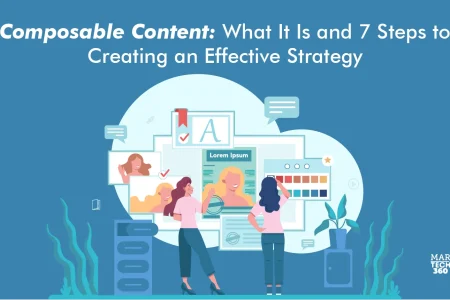What is Composable Content?
Composable content is a modern approach to digital content management. It allows marketers to create, manage, and distribute content modularly.
Composable management is a great way to improve the flexibility and reusability of any content.
Traditional content management often creates and uses content for a single purpose. For example, if you write a product description, the content will be only used for one specific page. With the composable content platform, you break each content into small, reusable sections.
This means you can take a block like “product benefits” and easily combine it with another block like “usage instructions” to create a product page.
Casper Aagaard Rasmussen (DK), Group SVP of Technology at Valtech and president of the MACH Alliance, says that content is the key to injecting emotion.
What is a Composable Content Platform?

A Composable Content Platform (CCP) is a flexible and modular approach to content management.
CCP includes governance features that allow you to easily modify roles and duties in response to your strategy or comfort level changes. It enables companies to adapt to evolving customer needs and user expectations.
Structured content plays a major role in compostable material. Text, graphics, photos, data, and even music are all parsed into compact, meaningful pieces that may be used in a variety of ways across all platforms and devices.
7 Steps on How to Create a Powerful Composable Content Strategy
Here’s a guide to help you develop an effective strategy:
1. Define Your Goals
Start by clearly defining what you want to achieve with your composable strategy. Consider your business objectives, target audience, and the types of content you need.
This will help you align your content efforts with overall business goals and customer needs.
2. Assess Your Current Content
Evaluate your existing content assets to identify what can be reused or repurposed. Look for content that can be broken down into smaller, modular pieces.
This assessment will help you understand your starting point and what gaps need to be filled.
3. Develop a Modular Content Framework
Create a framework for how your content will be structured. This involves defining content modules—individual pieces of content that can stand alone or be combined with others.
For example, you might have modules for product descriptions, testimonials, images, and videos. Ensure that these modules are stored in a presentation-neutral format, allowing for easy adaptation across different channels.
4. Choose the Right Technology
Select a CCP that supports your strategy. Look for platforms that are built on MACH principles (Microservices, API-first, Cloud-native, Headless).
These platforms will enable you to integrate various tools and services, allowing for a more cohesive content ecosystem. The right technology will also facilitate content delivery across multiple channels seamlessly.
5. Foster Collaboration Across Teams
Encourage collaboration between different teams, such as in marketing, design, and development. A composable content strategy thrives on teamwork, as it requires input from various stakeholders to create and manage content effectively.
Establish clear communication channels and workflows to ensure everyone is aligned and working towards common goals.
6. Implement Content Governance
Establish guidelines and best practices for content creation, management, and distribution. This governance will help maintain consistency in branding and messaging while content is relevant.
Define roles and responsibilities for content creators, editors, and managers to streamline the process.
7. Monitor and Optimize
After your content strategy is implemented, pay attention to its effectiveness. Utilize content analytics to monitor content consumption across several channels and collect consumer feedback.
You can use this information to pinpoint problem areas and gradually refine your content strategy.
Also Read: What Is Content Automation and Why Does Your Business Need It?
Key Benefits of Using Composable Content Platforms
Undoubtedly, customers are the cornerstone of any business. As technology evolves and more products and services become available, customers’ attention can easily shift.
People want better experiences at all times. 90% of customers expect perfect, seamless interactions. This means businesses need to differentiate themselves. Composability provides the flexibility to scale and evolve.
Consistent Digital Experience
A composable approach eliminates the need to copy and paste content across multiple, isolated systems. By unifying data on the backend, businesses can deliver a consistent digital experience across all frontend channels.
With content federation, developers and content teams access all information in one central place. API-based delivery ensures that any data update at the source is automatically reflected everywhere it’s used.
This approach empowers teams to scale content creation while employing complex data strategies, ensuring content remains fresh.
Content Reusability
Breaking content into reusable building blocks simplifies the process of launching new ideas. Engineers can rapidly create structured content models tailored to various use cases, integrating services from other technologies as needed.
Content creators can then mix and match these models to craft unique experiences without requiring custom development. This flexibility accelerates the time-to-market, enabling teams to adapt quickly to changing needs.
Flexible Approach
Composablility isn’t tied to any specific channel, process, or integration. It supports a flexible approach to architecture, allowing businesses to select the best tools for their evolving needs.
Unlike traditional systems, composable content doesn’t require a complete overhaul when the tech stack changes. Instead, individual content models can be swiftly adapted to support new services or data sources.
This adaptability ensures businesses can evolve with ease, staying competitive in a rapidly changing environment.
Cost Efficiency
Organizations can choose and pay for only the components they need, rather than investing in a full-scale content management system.This modular strategy reduces upfront costs and minimizes wasted resources on unused functionalities. By selectively investing in essential components, organizations can allocate their budget more effectively.
This approach also makes it easier to justify expenses by showing clear ROI from each selected component.
5 Composable Content Platforms for Smashing Outcome
Here are five notable composable content platforms for managing digital content:
Contentful
Contentful is a leading platform for creating and managing content. It enables businesses to deliver content across various channels efficiently. The focus on modular content lets teams mix and match experiences.
Contentstack
Contentstack excels in the composable digital experience space. It offers a flexible platform for modular content management and creation. The platform enhances customer experiences through seamless integration.
CrafterCMS
CrafterCMS is an open-source platform known for flexibility and scalability. It’s designed for both developers and content creators, making it versatile. The user-friendly interface simplifies the management of digital content.
OpenText Content Cloud
OpenText connects people, content, and processes through a composable architecture. This platform enhances productivity and supports better decision-making. Its robust integrations cater to diverse business needs effectively.
Adobe Experience Manager (AEM)
AEM is traditionally a comprehensive content management solution. It now supports composable strategies for better flexibility. AEM helps create reusable content for varied digital experiences.
Is Your Content Composable Ready?
Now that you have a solid understanding of composable content, effective strategies, and the best platforms available, are you ready to shift from traditional methods to a more futuristic, reliable, and user-friendly platform?

